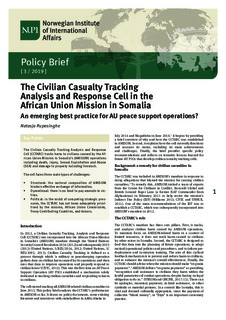| dc.contributor.author | Rupesinghe, Natasja | |
| dc.date.accessioned | 2019-01-25T15:08:56Z | |
| dc.date.available | 2019-01-25T15:08:56Z | |
| dc.date.created | 2019-01-24T14:59:10Z | |
| dc.date.issued | 2019 | |
| dc.identifier.uri | http://hdl.handle.net/11250/2582457 | |
| dc.description.abstract | The Civilian Casualty Tracking Analysis and Response Cell (CCTARC) tracks harm to civilians caused by the African Union Mission in Somalia’s (AMISOM) operations including death, injury, Sexual Exploitation and Abuse (SEA) and damage to property including livestock. The cell faces three main types of challenges: • Structural: the sectoral composition of AMISOM hinders effective exchange of information. • Operational: there is no fund to pay amends to victims. • Political: in the midst of competing strategic pressures, the CCTARC has not been adequately prioritised by the mission, African Union Commission, Troop Contributing Countries, and donors. | |
| dc.language.iso | eng | |
| dc.publisher | Norsk Utenriks Politisk Institutt | |
| dc.relation.ispartof | NUPI Policy Brief | |
| dc.relation.ispartofseries | NUPI Policy Brief;2019-03 | |
| dc.subject | Fredsoperasjoner | |
| dc.subject | Peace operations | |
| dc.subject | Afrika | |
| dc.subject | Africa | |
| dc.subject | Internasjonale organisasjoner | |
| dc.subject | International Organisations | |
| dc.title | The Civilian Casualty Tracking Analysis and Response Cell in the African Union Mission in Somalia: an emerging best practice for AU peace support operations? | |
| dc.type | Research report | |
| dc.description.version | publishedVersion | |
| dc.source.pagenumber | 4 | |
| dc.source.volume | 2019 | |
| dc.source.issue | 3 | |
| dc.identifier.cristin | 1664572 | |
| cristin.unitcode | 7471,13,0,0 | |
| cristin.unitname | Fred, konflikt og utvikling | |
| cristin.ispublished | true | |
| cristin.fulltext | original | |
